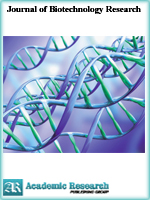Journal of Biotechnology Research
Online ISSN: 2413-3256
Print ISSN: 2413-8878
Print ISSN: 2413-8878
Quarterly Published (4 Issues Per Year)

Archives
Volume 8 Number 1 January 2022
Toxicity Effect of Cu2+ Contaminated Kitchen and Vegetable Wastes on Oxidative Stress Response of Black Soldier Fly Larvae, Hermetia Illucens
Authors: Eman Alaaeldin Abdelfattah ; Dyaa Bassiony ; Abdallah Nagah ; Mohamed A. Fawzy ; Mohammed Y. Hussein ; Habiba Mohamed Ibrahim ; Nada Y. Ibrahim ; Hamid Ashry ; Aya M. Aboelhassan ; Aya H. Mahmoud ; Dina H. Abd El-Monem
Pages: 7-25
DOI: doi.org/10.32861/jbr.81.7.25
Abstract
Environmental pollution sources including waste or metal accumulation, industrial and agricultural activities can be dangerous. Also, contaminated organic waste (COW) with metals especially, copper ions (Cu2+), can cause toxicity to various ecosystem components, enhance the production of reactive oxygen species (ROS) and consequently cause oxidative stress. The biochemical effect of the COW was monitored by assessing the oxidative stress parameters (OSP) using hydrogen peroxides (H2O2), protein carbonyls (PC), lipid peroxides (LP), catalase (CAT), superoxide dismutase (SOD), glutathione peroxidase (GPx), 2,2 diphenyl-1-picrylhydrazyl (DPPH), total antioxidant ability (TAA); β-esterase (β-EST); and total amount of protein (TAP) levels on the organic waste (kitchen and vegetable wastes); Hermetia illucens larvae; and larval excreta collected from 7-day post-treated kitchen and vegetables wastes with (1:10; g:mL) distilled water (DW) or 100 mg/mL Cu2+. The OSP levels were significantly higher in the experimental samples from Cu2+ groups than in the control one. Besides that, the OSP levels of H. illucens larvae feed on vegetable waste was significantly higher than those feed on kitchen waste except for β-EST, PC, and TPA. The best, cheap and easy parameters of antioxidants to ensure the entomoremediation ability are total antioxidant capacity. Possible impacts of accumulated and Cu2+ contaminated organic waste on H. illucens larvae were discussed. Also, the ability of insects to produce more antioxidants than input or output sources was approved. The potential use of the OSP as a bioindicator method of the bioremediation ability of H. illucens was proposed.
Antibacterial Activities of Some Medicinal Plants on Common Multidrug-Resistant Bacterial Isolates from Some Patients Attending Federal Medical Center, Birnin Kebbi, Nigeria
Authors: I. Sani ; S. A. Jega ; B. M. Danbare ; F. Bello ; A. Abdulhamid ; A. Abubakar ; H. A. Shindi
Pages: 1-6
DOI: doi.org/10.32861/jbr.81.1.6
Abstract
Bacterial infections are among the major causes of morbidity and mortality worldwide. The development of drug resistance to most antibiotics by bacterial species are pandemic, these necessitate the urgent need to search for new antibacterial drugs from the natural sources. Hence this research was aimed at evaluating the antibacterial activity of some medicinal plants on the most commonly drug resistant bacterial isolates from some patients attending Federal Medical Center (FMC) Birnin Kebbi, Nigeria. An ethno-botanical survey was carried out within Zuru Emirate and three (3) plant samples (Lonchocarpus laxiflorus root, Mitragyna inermis root and Lawsonia inermis root) were selected based on their number of citations and limited number of reported researches on the antibacterial activities of their roots. The multidrug resistant bacterial strains (Staplococcus aureus, Escherichia coli and Psuedomonas aeruginosa) obtained from FMC, Birnin Kebbi, were taken from nutrient agar slant and sub-cultured in nutrient agar plates. The antibacterial activities of the root methanol extracts of the plants were evaluated using agar-well diffusion method. Tube dilution method was used to determine the minimum inhibitory concentration of each plant extract. The preliminary phytochemical screening of the extracts was conducted using standard methods. Alkaloids, Flavaniods, Steriods, Tannins, saponnins and Phenols, were detected in L. laxiflorus root methanol extract, Flavaniods were absent in L. inermis and Alkaloids in M. inermis root methanol extracts. The plant extracts and their combinations showed varying degrees of antibacterial activities on the test isolates. The root methanol extracts of L. laxiflorus, L. inermis, L. laxiflorus/L. inermis, L. laxiflorus/M. inermis and L. inermis/M. inermis roots presented significant increase (p<0.05) in the zone of inhibition against S. aureus. Extracts of L. laxiflorus root, L. inermis root and combination of M. inermis root were able to suppress the growth of P. aeruginosa at lower dose of 25mg/ml. The antibacterial activity revealed that, the extracts exhibited dose dependent effect. L. inermis root had the highest activity and least MIC value of 12.5mg/ml against all the tested isolates. Thus, this research justified the use of these plants in traditional medicine for the treatment of bacterial infections and can also be considered as potential sources for development of new antibacterial agents that may be more effective, safe and readily accessible than the current antibiotics.



